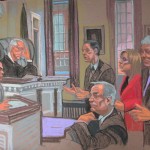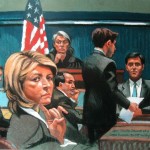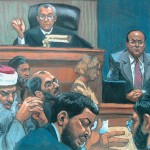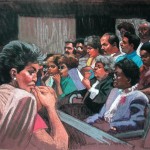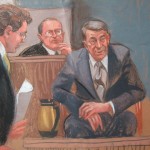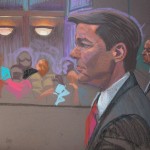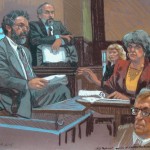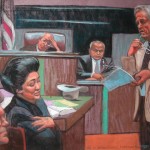
By Sally Deering
A terrorist flirted with her; a murderer stuck his tongue out at her; and a victim whose face was slashed shared with her the heart-stopping details of her attack – it’s all in a day’s work for courtroom artist Christine Cornell who has spent decades in the courtroom with her canvas and pastels drawing some of the biggest criminal trials in our country’s history.
Cornell, a Weehawken resident, has been drawing trials since the 1970s and images from her portfolio are sought after by documentary filmmakers like Ken Burns who features 30 Cornell drawings in his new film “The Central Park Five†which recently aired on PBS about the five young men convicted and later found not guilty of the rape attack of the “Central Park Joggerâ€. Just last week CNN contacted Cornell for a documentary on the 1980 murder of Beatles’ singer/songwriter John Lennon. They wanted to purchase the drawing Cornell did of gunman Mark David Chapman at his arraignment clutching the book “Catcher in the Ryeâ€.
When asked what makes a good courtroom drawing, Cornell says, “Composition. You have to have the key elements and be able to see and feel what the defendant is feeling. You need the judge, the witness, the attorney engaging the witness. It’s always more interesting when there’s more than one person. These drawings are more telling when there’s an interaction between people. You can look back at the drawing and it can actually tell the story.â€
Courtroom artists have been attending criminal trials and drawing the events inside the courtroom since the Salem Witch Trials of the 1600s. By the 1960s, courtroom artists were in demand because TV cameras were not allowed in the courtroom, but things began to change in the mid-1980s with more courts allowing cameras and since then, courtroom artists have seen a decline in numbers. Still, Cornell is considered one of the best in her field and travels all over the country to draw courtroom trials. And when she’s not in the courtroom, Cornell spends her time working on her first book, a visual history of the biggest trials of our times and a collaboration with her sister Irene Cornell who has covered most of the same trials as a reporter.
Famous Trials
Martha Stewart, Woody Allen, Bill Cosby, Donald Trump – these are just a few of the celebrities Cornell has covered in the courtroom. In December 1980, she was called in to draw the arraignment of Mark David Chapman who was clutching a copy of “Catcher in the Rye”. In the late 1980s, Cornell covered the trial of Bernie Goetz, dubbed the “Subway Vigilanteâ€. She also covered the trial of Leona Helmsley aka the “Queen of Meanâ€.  During her trial, Helmsley leaned over and asked Cornell: “Is my hair really that messy? If I looked like that my husband would divorce me”.
“I told her she was right, and I fixed it,†Cornell says.
In New York, Cornell also covered the Central Park Jogger trial. Watching the daily courtroom proceedings, Cornell felt that the boys on trial were not guilty as charged, she says.
“None of their confessions matched. None had a criminal history and it was hard to imagine they could get all the details wrong if they had participated in it,†Cornell says. “They couldn’t agree on what she was wearing, where the event took place. The sentiment in the courtroom was they were guilty of something. Everyone knew they shouldn’t have been out there, but they were kids. In the end when they got convicted, I figured okay, you don’t confess unless chances are you did something. So there it is. But all along I didn’t think they committed the rape.â€
For the Bernie Goetz Trial, Cornell did a series of five drawings that included a re-enactment of the crime where Goetz was attacked by a group of young men and alleged that he used his handgun in self-defense to shoot his attackers. Cornell drew the re-enactment by reading the transcript of Goetz’s confession. She also did a re-enactment drawing for the trial against the men who slashed the face of Marla Hanson.
“In that case I sat down with Marla and she described to me what happened,†Cornell says. “I drew the assailants from her descriptions. She told me that the guy carving her was smiling.â€
At John Gotti’s trial, Sammy “The Bull†Gravano testified to 19 murders and Cornell was there drawing it all in and on paper.
“He looked at me and stuck his tongue out at me,†Cornell laughs.
And when Ramses Yousef was on trial for the bombing of the World Trade Center in 1993, Cornell says his lawyer came over to her and relayed this message from his client: “If I beat this rap, will you go out with me?â€
In 2012, for the show “In Session†on Tru-TV, Cornell was courtroom-artist commentator for the Jerry Sandusky trial in Pennsylvania. It was her job to describe how the young men who accused Sandusky of sexual abuse were handling the pressures of telling their stories in public and how Sandusky was reacting.
“It was a challenging task I took seriously,†Cornell states on her website ChristineCornell.com where you can purchase prints of her courtroom drawings including one from the Sandusky trial. “People began to approach me on the street and tell me how I had added to their understanding and appreciation of the emotional goings-on inside.â€
How to Draw Justice
Born in New York and raised in Yonkers, Cornell grew up in a news-gathering home. Her dad Cameron Cornell was a popular newsman in radio and her sister Irene went on to be a reporter for CBS radio. Eager to go to college, Cornell was 16 when she entered the Pratt Institute where she earned a BFA in Drawing. She attended the College of Physicians and Surgeons – part of Columbia University – where she studied anatomy to hone her skill drawing the human body.
“We learned all the external musculature and it made it so I could draw figures from my imagination from every position,†Cornell says.
Honing your craft is important to being a courtroom artist, but so is having a strong sense of compassion, Cornell says. That’s because courtrooms are emotional places and the human drama is what makes a good drawing.
“If you’re missing out on the feeling, what’s the point,†Cornell says. “You’re trying to tell the emotional story as well as get their likeness.â€
To view Christine Cornell’s courtroom art, go to www.christinecornell.com
Â
For more info on “The Central Park Five†documentary, go to
http://www.pbs.org/kenburns/centralparkfive/
